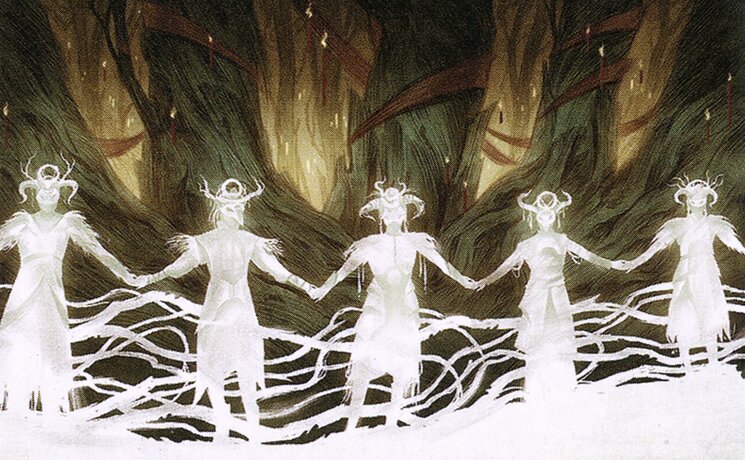
Rite of Harmony

Full Analysis
Generated on 2025-06-29T00:13:45.071119A Comprehensive Analysis of [Rite of Harmony]
TL;DR Summary
[Rite of Harmony] is an instant spell that allows a player to draw a card whenever a creature or enchantment enters their turn. With its moderate mana cost and versatility in interactions with other cards, it can be played as a standalone card but excels when paired with other ramp spells or enchantments.
Detailed Card Mechanics and Interactions
[Rite of Harmony] is an instant spell that resolves immediately after being cast. When played, the player draws a card for every creature or enchantment that enters their turn. This includes creatures put into play by spells like [Eternal Witness] or [Spectral Procession], as well as enchantments attached to creatures.
The card has two modes: its normal cost of {G}{W} and its flashback cost of {2}{G}{W}. When played normally, the player draws a card for every entering creature or enchantment. However, when cast from the graveyard using its flashback ability, the spell exiles itself, essentially "wasting" the spell.
Understanding the nuances of Rite of Harmony's interaction with creatures and enchantments is crucial. The card specifically states "Whenever a creature or enchantment you control enters this turn," which implies that it draws a card for only one entering entity per turn, even if multiple creatures or enchantments enter simultaneously. This distinction is vital when combining Rite of Harmony with other spells.
Strategic Uses, Combos, and Synergies
[Rite of Harmony] is an excellent addition to mid-to-late game decks seeking to ramp up card advantage quickly. It can be used to accelerate a deck's draw phase, allowing for more aggressive plays or setting up future turns with additional cards.
One notable combination with [Rite of Harmony] involves pairing it with other ramp spells like [Llanowar Elves]. This allows the player to draw additional cards while also ramping up their mana production. Another example is using Rite of Harmony in decks that include multiple enchantments, as the spell will draw for each entering creature or enchantment.
Another way to use [Rite of Harmony] effectively is by creating a "creature-based" draw engine. For instance, if you have a creature like [Eternal Witness], which can produce more creatures, attaching Rite of Harmony to it allows the player to capitalize on these additional entries and draw cards for each entering creature or enchantment.
Deckbuilding Roles and Archetypes
[Rite of Harmony] is versatile enough to fit into various deck archetypes. Generally, it serves as a mid-game draw engine that helps accelerate a deck's tempo.
One archetype where [Rite of Harmony] excels is in midrange control decks. These decks focus on ramping up their mana production and using spells like Rite of Harmony to draw additional cards while maintaining board presence with creatures.
Another example of playing Rite of Harmony involves combo decks, such as Merfolk or Elf decks, where the spell can be used to accelerate card draw during key phases of the game. In these cases, the player might use Rite of Harmony to draw a card before casting a key combo piece, setting up for future turns.
Format Viability and Competitive Context
In Modern and Standard formats, [Rite of Harmony] has been consistently popular due to its ability to accelerate card advantage while also providing protection against potential removal spells. However, it's worth noting that Rite of Harmony can struggle in more aggressive formats like Brawl or Pauper.
Rules Interactions and Technical Notes
The text of [Rite of Harmony] explicitly states the spell draws a card for "every creature or enchantment you control" entering the turn, emphasizing its focus on creatures and enchantments under the player's control. This is crucial to understand when playing with Rite of Harmony in combination with other spells.
Another important note regarding [Rite of Harmony]'s flashback cost is that it requires the spell to be cast from the graveyard. Even though played normally, Rite of Harmony will still resolve and draw a card for each entering creature or enchantment, regardless of being cast as a flashback.
Art, Flavor, and Historical Context
[Rite of Harmony] features an iconic art by Jason Chan that captures the essence of the card's theme: creating harmony among the natural world. The flavor text reads "And so we come to understand one another," emphasizing the idea of cooperation between all living things.
First printed in the 2002 set [Tempest], Rite of Harmony has been reprinted several times since, including in recent sets like [Guilds of Ravnica] and [War of the Spark].
Summary of Key Points
- Instant Spell: Resolves immediately after being cast.
- Draw Engine: Draws a card for every creature or enchantment you control entering this turn.
- Flashback Cost: Cast from graveyard for {2}{G}{W}, exiling the spell upon resolution.
- Interactions with Creatures and Enchantments: Rite of Harmony draws cards for each entering creature or enchantment under the player's control.
Conclusion
In conclusion, [Rite of Harmony] is a powerful draw engine that accelerates card advantage in mid-to-late game situations. Its ability to interact with other cards and its flexibility make it a versatile addition to various deck archetypes. While its power can be somewhat mitigated by removal spells or more aggressive formats, it remains a staple in many competitive decks.